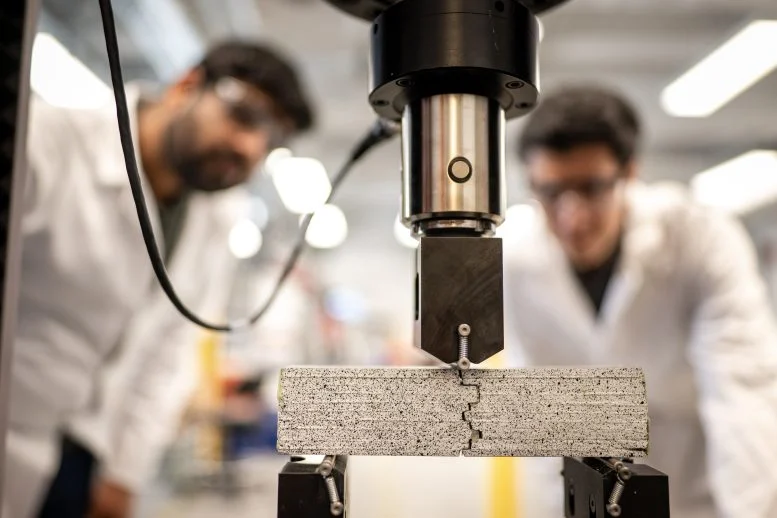Princeton engineers have developed a new cement-based composite inspired by mother-of-pearl that greatly increases its durability and flexibility. Engineers at Princeton University have developed a new cement composite inspired by materials found in oyster and abalone shells. This innovative material is 17 times more resistant to cracking than traditional cement, 19 times more flexible and can be deformed without breaking. This invention could significantly increase the crack resistance of a variety of brittle ceramic materials, from concrete to porcelain.
“If we can design concrete to resist crack propagation, we can make it stronger, safer and more durable,” said researcher Shashank Gupta, a graduate student in Reza Moini’s laboratory in the Department of Civil and Environmental Engineering.
In an article published June 10 in the journal Advanced Functional Materials A research team led by Moini, associate professor of civil and environmental engineering, reported that alternating cement paste and creating thin layers of polymer can significantly increase crack resistance and the ability to deform without completely failing (ductility).
Biological design and testing
The Moyney lab often looks to biology for inspiration when working on building materials. In this case, the team developed a composite inspired by a natural material called nacre, found in certain seashells. At a microscopic level, nacre consists of hexagonal tablets of the hard mineral aragonite bound together by a soft biopolymer, Gupta said.
Aragonite tablets significantly increase the strength of mother-of-pearl, while the biopolymer adds flexibility and resistance to cracking. The strengthening mechanism involves the sliding of aragonite tablets under tension, which, along with other mechanisms, allows the nacre to dissipate energy. This sliding action, combined with crack deflection and biopolymer deformation, allows nacre to withstand significant mechanical stress while maintaining its structural integrity, making it strong and resilient.
“This synergy between hard and soft components is critical to nacre’s excellent mechanical properties,” Gupta said.
The Princeton team developed innovative mother-of-pearl-inspired composites using common building materials such as Portland cement paste combined with a limited amount of polymer. They replaced the cement paste layers with the highly stretchable polymer polyvinylsiloxane. The researchers created small multilayer beams by replacing layers of cement paste with thin sheets of polymer. These beams were then subjected to a three-point bending test; where each beam was subjected to a bending test to evaluate resistance to cracking (or fracture strength).
Experimental results and observations
During the experiment, the researchers produced three types of beams. The first type consisted of alternating layers of cement paste and thin layers of polymer. In the second type, they used a laser to engrave hexagonal grooves into layers of cement paste. These corrugated sheets were then stacked with thin polymer layers in between. The third type was similar to the third, but the researchers cut out the cement entirely, creating individual hexagonal tablets connected by a polymer layer. These cement paste tablets lie on top of the polymer layer, just as aragonite lies on the mother-of-pearl biopolymer layer. These three types were compared with a continuous (monolithic) reference analogue of bulk cement paste.
Experiments showed that the fracture of the reference beams was brittle, that is, the beams broke suddenly and completely without ductility after reaching the fracture point. Beams with alternating layers, both corrugated and non-corrugated, showed increased plasticity and resistance to cracking.
The most significant results were observed for beams with completely separated hexagonal mother-of-pearl-like tablets. These beams showed 19 times greater plasticity and 17 times greater fracture toughness, while maintaining nearly the same strength as a solid cement paste beam.
“Our biotechnology-inspired approach is not just to mimic nature’s microstructure, but to learn from fundamental principles and use them to design man-made materials. One of the fundamental mechanisms that make the mother-of-pearl shell strong is the sliding of the tablet at the nanometer level. Here, balance is achieved with the properties of the polymer and the interface between them.” “We focus on the sliding mechanism of the tablets by designing the tabular structure embedded in the cement paste.” “In other words, we deliberately create defects in fragile materials to make them stronger,” Moini said.
Researchers noted that the results are based on laboratory conditions and that additional studies and research will be needed to develop methods to be used in the field. They are working to determine whether the structure’s viscosity and ductility apply to other ceramic materials, such as concrete, as well as cement paste.
“We are just scratching the surface; There will be many design opportunities to explore and design the fundamental properties of hard and soft materials, geometric aspects that influence interfaces and fundamental dimensional effects in building materials,” said Moini.













